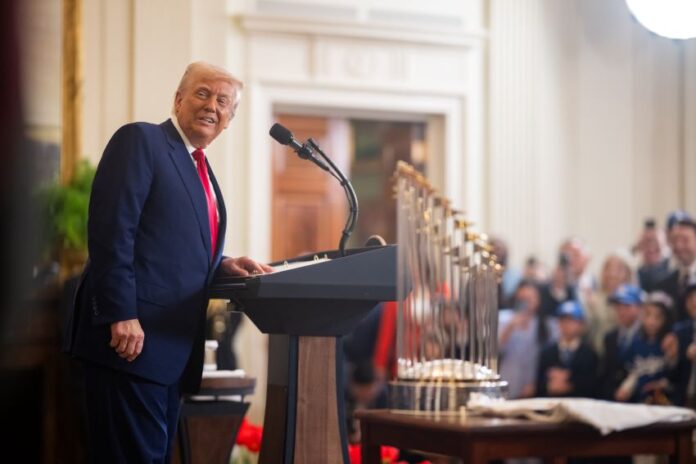After several hours of confusion and uncertainty on Wednesday, it was confirmed that Donald Trump’s latest tariff announcement didn’t change the status quo for Mexico on trade with the United States.
It all began with a lengthy Truth Social post by the U.S. president, in which he announced he was raising tariffs on imports from China to 125% and lowering the maximum “reciprocal tariff” rate for scores of other countries to 10% for 90 days.

The United States hasn’t imposed any so-called “reciprocal tariffs” on imports from Mexico and therefore it appeared that Mexico was unaffected by the announcement.
Enter U.S. Treasury Secretary Scott Bessent.
“Mexico and Canada, are they part of the 10%?” a reporter asked Bessent.
“Yes,” the treasury secretary responded, prompting The New York Times to report that “in a strange turn of events, the president seems to have added another 10 percent tariff to Canada and Mexico,” thus lifting the U.S. tariff on some Mexican products, such as steel and aluminum, to 35% — or so it appeared.
The Times reported that a White House official clarified “that was the case,” while the Canadian Broadcasting Corporation said it received a statement from the White House also confirming that the 10% tariff applied to goods from Canada and Mexico.
“What’s not clear … is what happens to the earlier tariffs on Canada [and Mexico], the so-called fentanyl tariff of 25 per cent on some products, and similar tariffs on steel, aluminum and some automotive trade,” CBC News said on Wednesday afternoon.
At Mexico News Daily, we continued to monitor developments. If an additional 10% tariff has been imposed on Mexico’s exports to the United States, as the NYT reported, why is the Mexican peso strengthening, I wondered.
I opened X and came across a post by José Díaz Briseño, the United States’ correspondent for Mexico’s Reforma newspaper.
• Bessent’s answer can be interpreted BOTH as a hike & as a reduction of the tariff rate applicable to Mexico & Canada.
• Proof of the improvised nature of Trump’s announcement.
— José Díaz Briseño (@diazbriseno) April 9, 2025
“Bessent’s answer can be interpreted BOTH as a hike & as a reduction of the tariff rate applicable to Mexico & Canada,” Briseño wrote.
“Proof of the improvised nature of Trump’s announcement,” he added.
With the peso having strengthened considerably after briefly trading above 21 on Wednesday morning, I reasoned that the U.S. tariff rate for all Mexican goods not covered by the USMCA free trade pact had been lowered to 10%.
“Yeah, that’s what I think,” a Mexico News Daily editor responded after I conveyed my thinking to her in a message.
Fast forward an hour and I read this: “CBC News is learning initial information that the 10 per cent baseline tariff applies to Canada may not be accurate.”
“No one knows what the deal is,” I wrote to my editor.
Eventually, the truth came out. The situation had not in fact changed for Mexico and Canada, the United States’ largest trading partners.
“From Washington: I am officially informed that we’re not included in the 10% reciprocal tariffs announced today,” Mexico’s Economy Minister Marcelo Ebrard wrote on X.
Desde Washington : me informan oficialmente no estamos incluidos en los aranceles recíprocos de 10% anunciados el día de hoy. Saludos.
— Marcelo Ebrard C. (@m_ebrard) April 9, 2025
A White House official — presumably not the one who said the 10% tariff did apply to Mexico and Canada — also confirmed that Mexico and Canada were not affected by Trump’s announcement of what he called a “90 day PAUSE” on “reciprocal tariffs” that are higher than 10%.
And with that the hours of confusion caused by Bessent and others finally came to an end.
So what US tariffs apply to imports from Mexico?
You’d be forgiven for not keeping up with all of the many and varied developments in recent months with regard to United States’ tariffs.
These are the tariffs that are currently in effect for imports from Mexico.
- Tariffs of 25% apply to all Mexican goods that don’t comply with the USMCA free trade pact. These tariffs took effect on March 4 when the United States imposed 25% duties on all imports from Mexico. Trump suspended tariffs on imports from Mexico covered by the USMCA free trade pact on March 6.
- Tariffs of 25% apply to Mexican steel and aluminum and hundreds of products made with those metals. These duties took effect on March 12. Since April 4, Mexican canned beer and empty aluminum cans have been subject to these tariffs.
- Tariffs on vehicles made in Mexico have been in effect since April 3. The United States imposed 25% tariffs on all vehicle imports on this date, but U.S. content in vehicles assembled in Mexico are exempt from the duty, lowering the effective tariff on vehicles made in Mexico.
Economy Minister Ebrard said last Thursday that the Mexican government’s “goal in the next 40 days is to achieve the best conditions among all countries of the world for the [Mexican] auto industry.”
“The same thing for steel and aluminum,” he added.
Mexico has not imposed any retaliatory tariffs on imports from the United States.
By Mexico News Daily chief staff writer Peter Davies (peter.davies@mexiconewsdaily.com)
